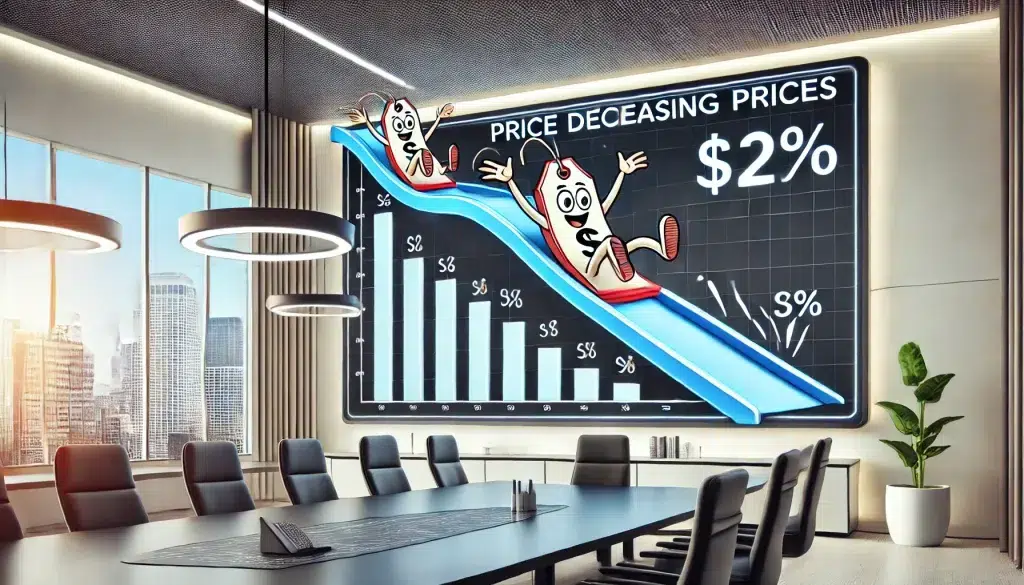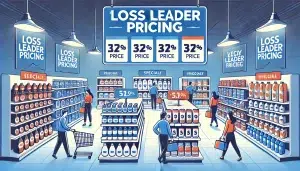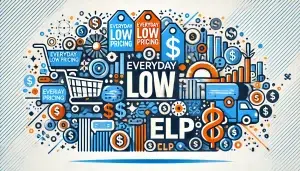
According to a report by Statista, the global consumer electronics market, where price skimming is commonly used, was valued at over $1 trillion in 2021. Understanding price skimming can be vital for businesses, especially those in the tech sector, looking to quickly recover research and development costs.
The tech industry, for example, often allocates around 10-15% of its revenue to R&D, making efficient cost recovery essential. By capturing the high-value market segment first, companies can ensure a substantial return on investment before competition intensifies.
This pricing strategy not only helps recoup costs but also establishes a premium brand image. However, careful market analysis and timing are required to avoid potential pitfalls.
Let’s delve deeper into the mechanics of price skimming, real-world examples, and pros and cons to understand how businesses can effectively implement this strategy.
What is Price Skimming?
Price skimming is a strategic pricing method used primarily in the launch phase of innovative products. Companies set high initial prices and gradually reduce them over time.
The strategy aims to maximize revenue from early adopters paying a premium for the latest technology. By initially setting a high price, companies can quickly recoup research and development costs during minimal competition. As the product matures and competitors enter the market, prices are lowered to attract a broader customer base.
This approach helps segment the market effectively. Initially, high prices target consumers with a higher willingness to pay. Over time, as prices decrease, the product becomes accessible to a broader audience, optimizing revenue throughout its lifecycle. High initial prices can also enhance the product’s perceived value and exclusivity, strengthening the brand’s reputation and contributing to long-term customer loyalty.
How Price Skimming Works
Price skimming aims to capitalize on early adopters who are less price-sensitive and eager to have the latest technology. Companies initially set a high price to maximize revenue from these early adopters. As sales from this segment are saturated, prices are lowered to attract a broader customer base. This staged price reduction helps tap into different market segments at various price points.
Capitalizing on Early Adopters
Early adopters are typically enthusiastic consumers who value being the first to own new products. These customers are willing to pay a premium for early access. For example, when Apple launches a new iPhone, the initial price is high to attract tech enthusiasts eager to experience the latest features and improvements. These early sales help Apple quickly recover research and development costs.
Broadening Customer Base
Once the initial excitement subsides and sales from early adopters begin to level off, the company lowers the price to appeal to more price-sensitive consumers. This second wave of customers includes those interested in the product but deterred by its initial high price. For instance, a few months after the iPhone’s release, Apple typically reduced the cost, making it more accessible to a broader audience. This strategy ensures continuous sales growth by gradually reaching different market segments.
Tapping into Different Market Segments
Price skimming allows a company to target various market segments over time strategically. Initially, the high price targets consumers who are more willing to pay. As the price decreases, the product becomes accessible to a broader audience, including the early and late majority, who are more price-sensitive. This phased approach maximizes revenue from each segment at different price points.
Real-Life Examples of Price Skimming

1. Apple iPhones:
Initial High Price: When a new iPhone model is launched, Apple sets a high price to attract early adopters. For example, the iPhone X was initially priced at $999.
After the initial surge in sales, Apple reduced the price of the iPhone X when newer models like the iPhone XS were released. This attracted more price-sensitive customers who waited for the price drop.
2. PlayStation Consoles:
Initial High Price: Sony launches new PlayStation consoles at a high price. The PlayStation 5, for instance, was initially priced at $499.
As sales from hardcore gamers and tech enthusiasts saturate, Sony reduced the price. This attracts more casual gamers and those waiting for a more affordable option.
3. Pharmaceutical Drugs:
Initial High Price: New prescription drugs are often introduced at high prices to recover research and development costs. For example, when a new medication hits the market, it is priced high to cater to patients who need the latest treatment.
Over time, as generic versions become available, the original drug’s price decreases, making it affordable for a broader patient population.
The Benefits of Price Skimming
Price skimming offers several strategic advantages for businesses launching innovative products. Here are some critical benefits explained in detail.
1. Recovery of R&D Costs
High initial prices help recover research and development expenditures. For instance, tech companies often spend millions on developing new products. They can quickly recoup these significant costs by setting a high price at launch. The pharmaceutical industry sees R&D costs for new drugs averaging $2.6 billion, and initial high pricing helps recover these investments.
2. Market Segmentation
Price skimming allows targeting different customer segments based on their willingness to pay. Initially, high prices target early adopters willing to pay a premium. As prices drop, more price-sensitive consumers enter the market. This approach ensures that the product appeals to different segments over time, maximizing revenue. For example, luxury car manufacturers often use this strategy, starting with high prices for new models and reducing them as newer models are released.
3. Brand Positioning
Launching a product at a high price creates a perception of exclusivity and high quality. This premium image can boost a brand’s overall market position. Apple, for instance, maintains a high-end brand image through price skimming, reinforcing consumer perceptions of innovation and superior quality.
4. Word-of-Mouth Marketing
Early adopters often become enthusiastic promoters of the product. Their positive reviews and recommendations can boost brand awareness and drive further sales when Tesla launched its Model S. The high price targeted tech-savvy, eco-conscious consumers who later promoted the car, enhancing Tesla’s market presence.
The Challenges of Price Skimming
Despite its benefits, price skimming also presents several challenges that businesses must manage carefully. Here are some common challenges detailed.
1. Customer Dissatisfaction
Early price reductions can upset initial customers who paid a higher price. This dissatisfaction can harm the brand’s reputation and lead to negative word-of-mouth. For example, when Apple dropped the iPhone’s price shortly after its release, early buyers were disgruntled, leading Apple to offer store credits to appease them.
2. Competitive Risk
Competitors may quickly introduce similar products, forcing faster price reductions. This risk can erode the initial advantage gained from skimming. For example, Samsung often releases new smartphones shortly after Apple’s launches, creating pressure on Apple to adjust its pricing strategy more rapidly.
3. Inventory Risks
Misjudging the market can lead to excess inventory if the high price deters too many customers. This situation can result in significant financial losses. For instance, when 3D television technology debuted, high prices and low consumer demand led to unsold inventory, causing manufacturers to incur heavy losses.
4. Quality Perception
The product must justify the high price through superior quality and features. If customers feel the product does not meet these expectations, they may feel cheated, damaging the brand. For example, if a new smartphone lacks innovative features to justify its high price, early adopters may voice their dissatisfaction, impacting future sales.
How to Introduce Price Skimming
Implementing price skimming requires a well-planned strategy that spans different phases of a product’s lifecycle. Here’s a step-by-step guide to help you understand and execute this strategy effectively.
Phase 1: Introduction
Set a high price to target early adopters. This phase is crucial for establishing your product’s value and recouping initial investments. Conduct thorough market research to identify the target audience willing to pay a premium for new and innovative products.
Understanding their needs and willingness to pay helps set the right initial price. Communicate your product’s unique features and benefits, highlighting why it’s worth the high price through marketing campaigns to build excitement and anticipation. Consider launching with limited availability to create a sense of exclusivity, driving demand among early adopters who don’t want to miss out.
Apple’s iPhone launches are a perfect example. The initial high price appeals to tech enthusiasts who value the latest features and are willing to pay more for early access.
Phase 2: Growth
Lower the price to attract more cost-sensitive customers. As the product gains traction, it’s time to broaden your customer base. Monitor sales data and market trends to determine the optimal time to reduce prices by looking for signs that sales from early adopters are plateauing.
Implement gradual price reductions rather than significant drops to avoid upsetting early customers. Each reduction should open the market to a new segment of price-sensitive customers. Use targeted promotions and marketing campaigns to reach new customer segments, highlighting the price reduction while continuing to emphasize the product’s value.
Sony’s PlayStation consoles often see price drops after the initial surge in sales. This approach helps attract a wider audience, including more casual gamers.
Phase 3: Maturity
Adjust pricing as competitors enter the market and the product becomes more mainstream. This phase ensures sustained market relevance and competitiveness. Keep a close eye on competitors’ pricing and market strategies, and adjust your prices to remain competitive without compromising profitability.
Introduce updates or variations of the product to maintain interest. This can justify maintaining higher prices even as the market becomes saturated. Offer bundles or discounts on complementary products to enhance value without directly reducing costs, maintaining perceived value while attracting new customers.
Pharmaceutical companies often reduce the price of original drugs when generic versions become available. They also introduce newer, improved versions to maintain market share.
Wrapping Up
Price skimming is a powerful strategy for maximizing revenue from new product launches, particularly in the tech industry. Companies can effectively manage market segments and recover development costs by setting high initial prices and gradually lowering them.
However, this strategy requires meticulous planning and market insight to avoid customer dissatisfaction and competitive pitfalls.




